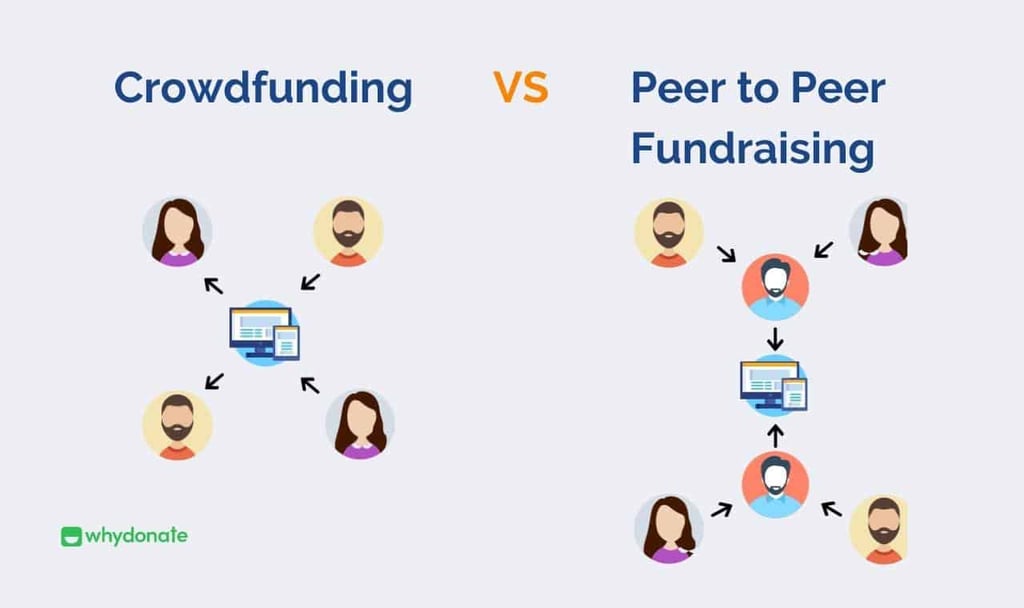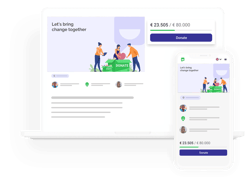Tens of years ago, there weren’t many options. Most non-profit organisations would go door-to-door, asking thousands of potential donors or trusts for their support. This exhausting way of fundraising has come to a dead end. Especially the arrival of the internet and the sharing economy has created a world of opportunities for organisations of all kinds.
One of those exciting developments is alternative financing, of which crowdfunding and peer-to-peer fundraising are the most common ones. Many people use these terms interchangeably, and although they are similar for sure, these are two separate fundraising techniques. This ambiguity around crowdfunding and peer-to-peer fundraising makes it a bit complex subject.
Sign up with WhyDonate Donation Website To Begin Your Crowdfunding Journey Now!
Table of Contents
What Is Crowdfunding?
The term itself is pretty much self-explanatory – crowdfunding is getting funding from the crowd. With crowdfunding, most people tend to give smaller amounts of money, like €5, €10, €50, or €100, or they give towards a specific project or cause. Crowdfunding has become very popular through the increase of suitable online fundraising platforms. It’s now used by individuals, companies, and non-profit organisations to raise money.

How Can I Raise Money For Personal Causes?
People worldwide use crowdfunding through online fundraising platforms for many reasons, such as healthcare expenses, money for college, mission trips, and tons of other projects, ideas, and initiatives. Let’s give you an example of how an individual could use crowdfunding to collect donations.
Let’s imagine Amy would like to raise money to pay for her university master’s degree. Amy sets up a campaign at any donation website to ask for donations. The campaign has an end date, financial goal, and a description of why and what Amy is raising money for.
Subsequently, she shares her online fundraising campaign on her social media platforms, such as Facebook and Twitter, and she emails her friends and family. Her friends and family then donate to her campaign, leave a message of support, and also share it with their networks. Amy keeps everyone in the loop by sharing messages, photos, and videos.
This is crowdfunding in a nutshell. Although, non-profit organisations and companies will have a more intense process.

What Is Peer-to-Peer Fundraising?
Peer-to-peer fundraising encourages supporters of a charity or non-profit organisation to raise money individually. It’s a bit of a subcategory of crowdfunding.
Instead of having one main crowdfunding page where everybody donates, you will have multiple individual fundraising pages with peer-to-peer fundraising, which the individual people will share with their own networks. All raised money will be received by the non-profit organisation at the end.
Contrary to crowdfunding, which is used by individuals, companies and non-profit organisations, peer-to-peer campaigns are usually only used by non-profit organisations.
This strategy uses the network of existing donors to encourage supporters to contact family, friends, colleagues, and peers for donations. Peer-to-peer fundraising is effective because it builds on existing relationships, uses existing donors of non-profit organisations, and builds social proof.
People are more inclined to trust a publication when it’s shared by a friend or family member. In most cases, peer-to-peer fundraising is linked to an event such as a walkathon or marathon.

What Is The Difference Between Crowdfunding And Peer-to-Peer Campaigns?
Both fundraising techniques are excellent and efficient ways to raise money. Which one you should choose largely depends on the resources available to your non-profit organisation. Crowdfunding is more accessible than a peer-to-peer campaign because you only need one donation webpage.
However, promoting this page amongst your donors and followers requires an investment of time and energy. Peer-to-peer fundraising is more complex and requires more time and planning. In order to raise funds, you will need to find your supporters and provide training.
Additionally, there should be constant support available to them. However, since peer-to-peer fundraising is exponential, as all individual campaigns of your support have a ripple effect and will bring you more donors, it can bring you more visibility and raise more money than a crowdfunding campaign.
Peer-to-peer events do require more planning, execution time, and direct involvement of the participants than crowdfunding campaigns. Nevertheless, the result can be unbelievable.
You can do both on the fundraising platform WhyDonate with utmost ease. WhyDonate with equipped with certain fundraising tools where you get to customise individual campaign pages for personal campaigns. Not only is WhyDonate a great crowdfunding and peer-to-peer platform, but it is also a one-stop solution for managing personal fundraising pages and acts as a donor management platform.
Choose To Crowdfund If:
- You have a small team fundraising campaign
- You have lots of followers on your social media platforms
- You want to keep it simple
- You don’t have a lot of time
- You have a fundraising goal for a specific cause or campaign
What Are The Benefits Of Peer-to-peer Fundraising?
- You have enough employees to support the fundraising campaign
- You can count on a loyal group of supporters and fans
- You have time to plan and execute the campaign
- You have a team that is familiar with using online tools
- You have a good process in place for the retention of donors

How To A Start Peer-to-peer Fundraiser?
Whether you choose to go for peer-to-peer fundraising or crowdfunding, you should always keep the following key elements in mind:
-
Targets
Targets will be different for each and every organisation, but they should always be realistic and achievable.
-
Recurring donations
Look for supporters who regularly donate to your organisation, who take part in your volunteering days, and who attend your fundraising events. These are your best bets for peer-to-peer fundraising. If you decide to go for a crowdfunding campaign, you need to be transparent about your marketing strategy.
-
Branding
Make sure you create and launch a branded website for your crowdfunding. Donors are more inclined to trust a website with official branding to make donations. You will need to prepare branded materials to send to your individual fundraisers for a peer-to-peer fundraising campaign.
-
Images and videos
Interesting and engaging videos and images will attract people to your page and will keep them there.
-
Social media
Both fundraising techniques rely on distribution on your social media platforms, so you need to ensure donors can tell their friends about your campaign. Create written templates and materials that can be used.
-
Updates
Make sure you constantly post updates about your campaign. It exhibits your fundraising efforts and your engagement towards your fundraising campaign.
-
Be thankful
As soon as you reach your fundraising targets, it’s time to thank your donors for their contributions and your supporters for their hard work.

Crowdfunding & Peer-to-Peer Fundraising – Similarities
- Both are forms of alternative financing.
- Both usually receive multiple (smaller) donations instead of only a few big donations.
- Both crowdfunding and peer-to-peer fundraising campaigns require specialised fundraising tools and technology.
Crowdfunding vs Peer-to-Peer Fundraising: Differences
- Whilst crowdfunding is usually hosted on one website, peer-to-peer fundraising can be done on multiple websites to share and promote the campaign.
- Individuals, companies, and non-profit organisations can all choose to crowdfund to raise money for a specific goal. Non-profit organisations and organisations choose peer-to-peer fundraising by including supporters in the process.
- Big crowdfunding platforms offer action platforms to hold crowdfunding campaigns. Non-profit organisations usually use their own websites for peer-to-peer fundraising.
- Crowdfunding can have more control over the messaging and brand consistency.

Conclusion
Both crowdfunding and peer-to-peer fundraising through action platforms are useful fundraising techniques for non-profit organisations. Both have their pros and cons, but they both can deliver excellent results. By analysing your goals, resources, and audience, you can decide which platform suits your individual situation best!
We hope this article has helped you and informed you about the differences and similarities between crowdfunding and peer-to-peer fundraising. It should help you to decide the best option for your organisation so that you can start a successful fundraising strategy for your campaign!
If you’re interested in more hints, tips, tricks, and resources about fundraising for non-profit organisations, check out our latest non-profit blog here.

















